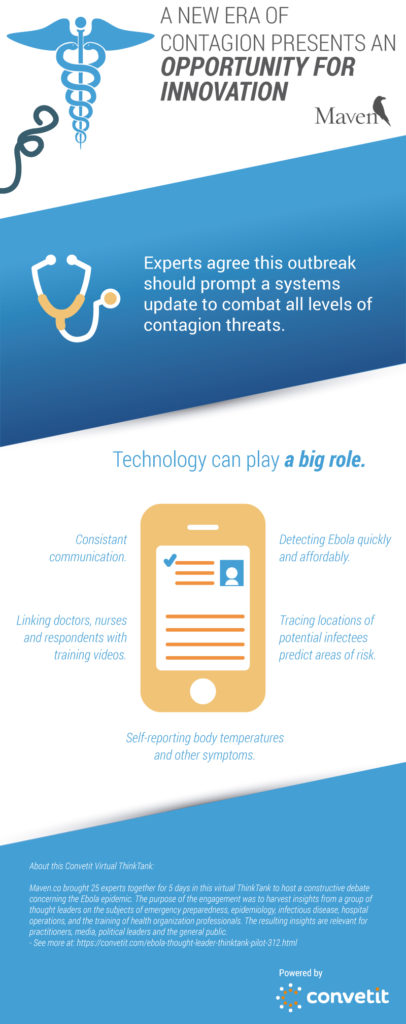
Our moderated five-day Ebola ThinkTank generated hundreds of pages of actionable insights and recommendations. To capture and summarize the key findings that pertained to detection, treatment, and containment, we’ve created this infographic. Below are critical excerpts from our Mavens that highlight the key developments in this discussion.
Key Takeaways: Detection, Treatment, and Containment
Detection Best Practices:
“When flu season starts there will be (needless) panic in the streets (to say nothing of emergency departments and clinics).”
– Michael Burg“The main difference is that influenza has respiratory symptoms, while Ebola does not. The fatigue and malaise is the same, but Ebola does not cause cough and URI symptoms.”
– Jennifer Hanrahan“However, what I am not seeing or hearing is one EVD symptom that I have seen in the field in Sudan and in the DRC. It is a mystery to me why I have not seen it mentioned in the media. Hiccups! In clinics in Africa, when I have encountered potential VHF’s and I hear a patient with hiccups my antenna go up immediately. I have only ever seen this symptom with EVD.”
– Dr. Roy J. McGroarty“Sprinting into the race to commercialize an Ebola diagnostic, San Diego’s Genalyte says it has developed a 10-minute Ebola test. The company said its test uses one drop of blood from a finger prick, and offers results in as fast as 10 minutes on its diagnostic platform. The test detects Ebola proteins, even at an early stage of infection before the person is showing obvious symptoms.”
– Jack Woodall
Local Containment Best Practices:
“Decontamination is critical. I don’t know why some of you seem to think that Ebola virus does not last on surfaces or that decontamination is only for psychological reassurance of the public. If you would like to know more please review: T.J. Piercy, S.J. Smither, J.A. Steward, L. Eastaugh and M.S. Lever. The survival of filoviruses in liquids, on solid substrates and in a dynamic aerosol. Journal of Applied Microbiology Journal of Applied Microbiology 109, 1531–1539 (ISSN 1364-5072).”
– Aileen Marty“Today, Friday 24 October, has been full of Craig Spencer, and New York has degenerated into total paranoia, culminating in the NY/NJ governors mandating 21-day “house arrest” for all returning aid workers in their states. This translates into MSF & other aid agencies being forced to pay 3 weeks salary for staff prevented from returning to the field, and discouraging any volunteers from those 2 states signing up in the first place, setting back control efforts in the 3 worst affected countries which are exporting cases to the USA & Europe.
I suppose the rationale is that the health & GDP per capita of the 20 million inhabitants of NY state + the 9 million inhabitants of NJ outrank those of the 22 million inhabitants of the 3 worst affected countries combined.
Everyone forgets that in 40 yearsuntil this week, the group said in a statement, “out of more than 700 expatriate staff deployed so far to West Africa, no [fusion_builder_container hundred_percent=”yes” overflow=”visible”][fusion_builder_row][fusion_builder_column type=”1_1″ background_position=”left top” background_color=”” border_size=”” border_color=”” border_style=”solid” spacing=”yes” background_image=”” background_repeat=”no-repeat” padding=”” margin_top=”0px” margin_bottom=”0px” class=”” id=”” animation_type=”” animation_speed=”0.3″ animation_direction=”left” hide_on_mobile=”no” center_content=”no” min_height=”none”][Doctors Without Borders] staff person has developed confirmed Ebola symptoms after returning to their home country.” So why should any aid workers face quarantine after returning from a stressful few weeks in the hot zone? Piling stress on stress.”
– Jack Woodall“Let’s develop the apps for personal tracing and gathering of key health information (temperature, pulse, etc.). Put a water-proof bracelet on travelers coming into the country from Ebola-affected areas that can ensure privacy while tracking key health parameters that communicates directly and can only be removed by our Public Health service. This can be used not only to help keep our points of entry safe but also to provide a safe virtual rather than actual quarantine for persons with low risk exposure to Ebola.”
– Aileen Marty“Possible early containment procedure – During my practice of emergency management (logistical) in the military during a medical outbreak I have always discussed with my military and civilian counterparts about major airports having small medical containment facilities on their grounds. The principal initial entry point of any disease into the U.S. are through the airports. If a passenger(s) has been detected to be showing symptoms they can moved to that containment room until medical professionals arrive to safely transport the patient(s).”
– Melvin Fleming, MBA“My position has always been the same: fight Ebola from its source. It is better to quarantine and treat people (including health workers or doctors) in the “ground zero” or in Ebola-infected countries rather than allowing them to travel home or to other countries and quarantine them later on if symptoms manifest. The former is more efficient and probably cheaper than the latter. Owing to mobility of people, it is difficult to trace or monitor people infected with Ebola once if they enter airports and interact with others. So, bring in the “fire fighters” (Ebola experts, doctors, caregivers, etc) to West Africa to extinguish the “fire” (Ebola epidemic). Strictly screen people entering or leaving Ebola-infected West African countries at the airports, borders, or ports or impose a total travel ban.”
– Dr. Vivencio Ballano“One of the most important things for containing this disease and halting the spread will be early identification with a rapid, sensitive and specific test, that can be done on-site. I believe that we will continue to see an escalation in possible cases, and the current protocols significantly disrupt healthcare for other patients. In addition, being able to use a rapid test in West Africa could help halt the spread there. Identification and isolation of cases has halted the spread of infection in the past, and while a much larger task now, would still work.”
– Jennifer Hanrahan“Public health authorities, working through the media, should repeatedly remind the public of all the people who have not contracted Ebola despite potential exposures. Available resources should be focused on efforts to identifying and monitoring contacts – the most effective and proven strategy – rather that disinfection of public places and other activities that consume resources and are largely for show.”
– Harry Hull“Regarding detection, a ‘rapid’ test for the virus for those in the incubation period could be an important adjunct to quarantine. The test takes 6 hours. Could the test be instituted in airports for high-risk travelers, with an imposed wait for the test results in airport quarantine, then release or further quarantine happen based on the test results? A rapid test for the virus in the asymptomatic seems like one of the best next goals in stopping Ebola’s spread. ”
– Marc Cicero
[/fusion_builder_column][/fusion_builder_row][/fusion_builder_container]
Related Post
Categories
Recent Articles

Has the world of consulting changed forever?

Experts on demand

Internal talent marketplace

Internal talent marketplace platform

What is an internal talent marketplace?

